Evaluating the Performance of Protective Barriers against Debris Flows Using Coupled Eulerian Lagrangian and Finite Element Analyses
Abstract
:1. Introduction
2. Methodology
2.1. Coupled Eulerian–Lagrangian Method (CEL)
2.2. Rheological Model of Debris Flow
3. Validation and Investigation
3.1. Model Validation
3.2. Estimating Flow Velocities at Different Locations on Hobart Rivulet Terrain
3.2.1. Study Area
3.2.2. Simulation and Estimation
3.3. Simulation of Boulder–Barrier Interactions
3.3.1. Identifying the Weakest I-Beam Post of the Barrier
3.3.2. Effect of Boulder Impact Velocity
3.3.3. Effect of Boulder Impact Height
3.3.4. Effect of Boulder Size
3.3.5. Effect of Boulder Orientation
4. Benchmark Simulations of Flow–Boulder–Barrier Interactions
4.1. Parameters and Simulations
4.2. Results, Analysis, and Comparison
5. Conclusions
- The CEL model is validated by simulating experimental debris flow tests from Ng et al. [52] using the Bingham model. The good agreement between the CEL model and experimental data suggests accurate predictions of flow velocities, boulder velocities, and impact forces. Subsequent examinations of debris flow velocities along the Hobart Rivulet using a 3D CEL model reveal distinct flow dynamics. Beginning at 3 m/s, flow velocities surged downstream, stabilising at 7 m/s, 12 m/s, 14 m/s, and 16 m/s, indicating increasing momentum and turbulence downstream. These findings provide a foundation for subsequent investigations into boulder-barrier interactions, with a designated velocity of 12 m/s used for the structural effect analysis in Section 3.3, and the release of boulders at a specific location for benchmark simulation in Section 4.
- By accounting for the dynamic nature of debris flows and various impact scenarios, the simulations of boulder–barrier interactions are conducted to assess the performance of I-beam post barriers in Hobart Rivulet. The study identifies weak points in the protective structure using the failure ratio, which measures the proportion of elements failing upon impact. The results show minimal variation in impact forces across different posts, but significant differences in failure ratios, pinpointing FN9 and BN3 as the weakest, with FN9 being critical due to its front-row position.
- The simulation results of boulder–barrier interactions also reveal that higher boulder velocities strongly correlate with increased failure ratios and impact forces, while varying impact heights reveal that the middle sections of the posts are more vulnerable. Additionally, larger boulders result in higher failure ratios, while different impact orientations lead to varying structural damages, with orientation (b) yielding the highest failure ratio and orientation (c) the highest impact force.
- Numerical models conducted for different boulder sizes (0.5 m, 1.5 m, and 2.5 m) highlight the effectiveness of the CEL model in capturing the complex interactions between debris flow, boulders, and the I-beam barrier on a real rivulet terrain. The findings indicate that larger boulders significantly increase the failure ratio and impact force on the barrier, with failure ratios stabilising at approximately 4%, 65%, and 80% for boulder sizes of 0.5 m, 1.5 m, and 2.5 m, respectively. Notably, the CEL model stands out for handling multiple boulders without assuming impact locations or orientations. Moreover, there is a noticeable difference in the velocities of smaller boulders, indicating the sensitivity of FE models to size variations. The comparative analysis using FE models shows good agreement with CEL results, although the FE models predict slightly higher impact forces and different failure distributions. This complementarity provides valuable insights into the utility of both approaches in enhancing structural resilience and optimising barrier design against debris flow impacts.
Author Contributions
Funding
Institutional Review Board Statement
Informed Consent Statement
Data Availability Statement
Conflicts of Interest
References
- Comiti, F.; Lucía, A.; Rickenmann, D. Large wood recruitment and transport during large floods: A review. Geomorphology 2016, 269, 23–39. [Google Scholar] [CrossRef]
- Thouret, J.-C.; Antoine, S.; Magill, C.; Ollier, C. Lahars and debris flows: Characteristics and impacts. Earth Sci. Rev. 2020, 201, 103003. [Google Scholar] [CrossRef]
- Vagnon, F. Design of active debris flow mitigation measures: A comprehensive analysis of existing impact models. Landslides 2020, 17, 313–333. [Google Scholar] [CrossRef]
- He, J.; Zhang, L.; Fan, R.; Zhou, S.; Luo, H.; Peng, D. Evaluating effectiveness of mitigation measures for large debris flows in Wenchuan, China. Landslides 2022, 19, 913–928. [Google Scholar] [CrossRef]
- Xu, Y.; Xu, Z.-D.; Guo, Y.-Q.; Jia, H.; Huang, X.; Wen, Y. Mathematical modeling and test verification of viscoelastic materials considering microstructures and ambient temperature influence. Mech. Adv. Mater. Struct. 2022, 29, 7063–7074. [Google Scholar] [CrossRef]
- Dai, J.; Yang, C.; Gai, P.-P.; Xu, Z.-D.; Yan, X.; Xu, W.-P. Robust damping improvement against the vortex-induced vibration in flexible bridges using multiple tuned mass damper inerters. Eng. Struct. 2024, 313, 118221. [Google Scholar] [CrossRef]
- Shen, W.G.; Zhao, T.; Zhao, J.D.; Dai, F.; Zhou, G.G. Quantifying the impact of dry debris flow against a rigid barrier by DEM analyses. Eng. Geol. 2018, 241, 86–96. [Google Scholar] [CrossRef]
- Choi, S.K.; Park, J.Y.; Lee, D.H.; Lee, S.R.; Kim, Y.T.; Kwon, T.H. Assessment of barrier location effect on debris flow based on smoothed particle hydrodynamics (SPH) simulation on 3D terrains. Landslides 2021, 18, 217–234. [Google Scholar] [CrossRef]
- Zhang, Y.S.; Chen, J.P.; Tan, C.; Bao, Y.D.; Han, X.D.; Yan, J.H.; Mehmood, Q. A novel approach to simulating debris flow runout via a three-dimensional CFD code: A case study of Xiaojia Gully. Bull. Eng. Geol. Environ. 2021, 80, 5293–5313. [Google Scholar] [CrossRef]
- Vicari, H.; Tran, Q.A.; Nordal, S.; Thakur, V. MPM modelling of debris flow entrainment and interaction with an upstream flexible barrier. Landslides 2022, 19, 2101–2115. [Google Scholar] [CrossRef]
- Sha, S.; Dyson, A.P.; Kefayati, G.; Tolooiyan, A. Simulation of debris flow-barrier interaction using the smoothed particle hydrodynamics and coupled Eulerian Lagrangian methods. Finite Elem. Anal. Des. 2023, 214, 103864. [Google Scholar] [CrossRef]
- Liu, C.; Yu, Z.; Zhao, S. A coupled SPH-DEM-FEM model for fluid-particle-structure interaction and a case study of Wenjia gully debris flow impact estimation. Landslides 2021, 18, 2403–2425. [Google Scholar] [CrossRef]
- Guo, J.; Cui, Y.F.; Xu, W.J.; Yin, Y.Z.; Li, Y.; Jin, W. Numerical investigation of the landslide-debris flow transformation process considering topographic and entrainment effects: A case study. Landslides 2022, 19, 773–788. [Google Scholar] [CrossRef]
- Luo, G.; Zhao, Y.; Shen, W.; Wu, M. Dynamics of bouldery debris flow impacting onto rigid barrier by a coupled SPH-DEM-FEM method. Comput. Geotech. 2022, 150, 104936. [Google Scholar] [CrossRef]
- Liang, Z.; Choi, C.E.; Zhao, Y.; Jiang, Y.; Choo, J. Revealing the role of forests in the mobility of geophysical flows. Comput. Geotech. 2023, 155, 105194. [Google Scholar] [CrossRef]
- Yu, D.; Tang, L.; Chen, C. Three-dimensional numerical simulation of mud flow from a tailing dam failure across complex terrain. Nat. Hazards Earth Syst. Sci. 2020, 20, 727–741. [Google Scholar] [CrossRef]
- Zhou, J.W.; Cui, P.; Yang, X.G. Dynamic process analysis for the initiation and movement of the Donghekou landslide-debris flow triggered by the Wenchuan earthquake. J. Asian Earth Sci. 2013, 76, 70–84. [Google Scholar] [CrossRef]
- Li, X.P.; Yan, Q.W.; Zhao, S.X.; Luo, Y.; Wu, Y.; Wang, D.P. Investigation of influence of baffles on landslide debris mobility by 3D material point method. Landslides 2020, 17, 1129–1143. [Google Scholar] [CrossRef]
- Ng, C.W.W.; Wang, C.; Choi, C.E.; De Silva, W.; Poudyal, S. Effects of barrier deformability on load reduction and energy dissipation of granular flow impact. Comput. Geotech. 2020, 121, 103445. [Google Scholar] [CrossRef]
- Si, G.W.; Chen, X.Q.; Chen, J.G.; Tang, J.B.; Zhao, W.Y.; Jin, K. The Impact Force of Large Boulders with Irregular Shape in Flash Flood and Debris Flow. KSCE J. Civ. Eng. 2022, 26, 4276–4289. [Google Scholar] [CrossRef]
- Sha, S.; Dyson, A.P.; Kefayati, G.; Tolooiyan, A. An Equivalent Stiffness Flexible Barrier for Protection Against Boulders Transported by Debris Flow. Int. J. Civ. Eng. 2024, 22, 705–722. [Google Scholar] [CrossRef]
- Sha, S.; Dyson, A.P.; Kefayati, G.; Tolooiyan, A. Analysis of Debris Flow Protective Barriers Using the Coupled Eulerian Lagrangian Method. Geosciences 2024, 14, 198. [Google Scholar] [CrossRef]
- Chen, H.X.; Li, J.; Feng, S.J.; Gao, H.Y.; Zhang, D.M. Simulation of interactions between debris flow and check dams on three-dimensional terrain. Eng. Geol. 2019, 251, 48–62. [Google Scholar] [CrossRef]
- Kefayati, G.; Tolooiyan, A.; Dyson, A.P. Finite difference lattice Boltzmann method for modeling dam break debris flows. Phys. Fluids 2023, 35, 013102. [Google Scholar] [CrossRef]
- Zhao, L.; He, J.W.; Yu, Z.X.; Liu, Y.P.; Zhou, Z.H.; Chan, S.L. Coupled numerical simulation of a flexible barrier impacted by debris flow with boulders in front. Landslides 2020, 17, 2723–2736. [Google Scholar] [CrossRef]
- Chehade, R.; Chevalier, B.; Dedecker, F.; Breul, P.; Thouret, J.-C. Effect of Boulder Size on Debris Flow Impact Pressure Using a CFD-DEM Numerical Model. Geosciences 2022, 12, 188. [Google Scholar] [CrossRef]
- Sha, S.; Dyson, A.P.; Kefayati, G.; Tolooiyan, A. Modelling of debris flow-boulder-barrier interactions using the Coupled Eulerian Lagrangian method. Appl. Math. Model. 2024, 127, 143–171. [Google Scholar] [CrossRef]
- Greco, M.; Di Cristo, C.; Iervolino, M.; Vacca, A. Numerical simulation of mud-flows impacting structures. J. Mt. Sci. 2019, 16, 364–382. [Google Scholar] [CrossRef]
- Kokuryo, H.; Horiguchi, T.; Ishikawa, N. Safety assessment method of steel protective structure against large-scale debris flow. Int. J. Prot. Struct. 2022, 13, 509–538. [Google Scholar] [CrossRef]
- Sun, X.; Chen, M.; Bi, Y.; Zheng, L.; Che, C.; Xu, A.; Tian, Z.; Jiang, Z. Protective effects of baffles with different positions, row spacings, heights on debris flow impact. J. Mt. Sci. 2024, 21, 2352–2367. [Google Scholar] [CrossRef]
- Lin, C.H.; Hung, C.; Hsu, T.Y. Investigations of granular material behaviors using coupled Eulerian-Lagrangian technique: From granular collapse to fluid-structure interaction. Comput. Geotech. 2020, 121, 103485. [Google Scholar] [CrossRef]
- Mazengarb, C.; Rigby, T.; Stevenson, M. Geological Survey Technical Report 37: Kunanyi/Mount Wellington Debris Flow Susceptibility and Hazard Assessment; Mineral Resources Tasmania: Rosny Park, Australia, 2023. Available online: https://www.mrt.tas.gov.au/mrtdoc/dominfo/download/TR37/ (accessed on 9 August 2024).
- Stevenson, M.; Mazengarb, C.; Woolley, R. Historical Assessment of the 1872 Glenorchy Debris Flow: A Basis for Modelling the Large Debris Flow Hazard from the Wellington Range, Hobart; Mineral Resources Tasmania: Rosny Park, Australia, 2016. Available online: https://www.researchgate.net/publication/297549846 (accessed on 9 August 2024).
- Kain, C.L.; Rigby, E.H.; Mazengarb, C. A combined morphometric, sedimentary, GIS and modelling analysis of flooding and debris flow hazard on a composite alluvial fan, Caveside, Tasmania. Sediment. Geol. 2018, 364, 286–301. [Google Scholar] [CrossRef]
- Qiu, G.; Henke, S.; Grabe, J. Application of a Coupled Eulerian–Lagrangian approach on geomechanical problems involving large deformations. Comput. Geotech. 2011, 38, 30–39. [Google Scholar] [CrossRef]
- Chen, X.Y.; Zhang, L.L.; Chen, L.H.; Li, X.; Liu, D.S. Slope stability analysis based on the Coupled Eulerian-Lagrangian finite element method. Bull. Eng. Geol. Environ. 2019, 78, 4451–4463. [Google Scholar] [CrossRef]
- Tatnell, L.; Dyson, A.P.; Tolooiyan, A. Coupled Eulerian-Lagrangian simulation of a modified direct shear apparatus for the measurement of residual shear strengths. J. Rock Mech. Geotech. Eng. 2021, 13, 1113–1123. [Google Scholar] [CrossRef]
- Wang, P.Y.; Lian, C.C.; Yue, C.X.; Wu, X.Y.; Zhang, J.M.; Zhang, K.; Yue, Z.F. Experimental and numerical study of tire debris impact on fuel tank cover based on coupled Eulerian-Lagrangian method. Int. J. Impact Eng. 2021, 157, 103968. [Google Scholar] [CrossRef]
- Huang, Y.; Zhu, C. Simulation of flow slides in municipal solid waste dumps using a modified MPS method. Nat. Hazards 2014, 74, 491–508. [Google Scholar] [CrossRef]
- Zhu, C.; Huang, Y.; Zhan, L.-t. SPH-based simulation of flow process of a landslide at Hongao landfill in China. Nat. Hazards 2018, 93, 1113–1126. [Google Scholar] [CrossRef]
- Kang, D.H.; Hong, M.; Jeong, S. A simplified depth-averaged debris flow model with Herschel-Bulkley rheology for tracking density evolution: A finite volume formulation. Bull. Eng. Geol. Environ. 2021, 80, 5331–5346. [Google Scholar] [CrossRef]
- Chen, Y.; Zhang, L.; Wei, X.; Jiang, M.; Liao, C.; Kou, H. Simulation of runout behavior of submarine debris flows over regional natural terrain considering material softening. Mar. Georesources Geotechnol. 2023, 41, 175–194. [Google Scholar] [CrossRef]
- Hussin, H.; Quan Luna, B.; Van Westen, C.; Christen, M.; Malet, J.-P.; Van Asch, T.W. Parameterization of a numerical 2-D debris flow model with entrainment: A case study of the Faucon catchment, Southern French Alps. Nat. Hazards Earth Syst. Sci. 2012, 12, 3075–3090. [Google Scholar] [CrossRef]
- Tang, J.; Cui, P.; Wang, H.; Li, Y. A numerical model of debris flows with the Voellmy model over a real terrain. Landslides 2023, 20, 719–734. [Google Scholar] [CrossRef]
- Kafle, J.; Kattel, P.; Mergili, M.; Fischer, J.-T.; Pudasaini, S.P. Dynamic response of submarine obstacles to two-phase landslide and tsunami impact on reservoirs. Acta Mech. 2019, 230, 3143–3169. [Google Scholar] [CrossRef]
- Zhu, C.; Huang, Y.; Sun, J. A granular energy-controlled boundary condition for discrete element simulations of granular flows on erodible surfaces. Comput. Geotech. 2023, 154, 105115. [Google Scholar] [CrossRef]
- Wang, F.; Wang, J.D.; Chen, X.Q.; Zhang, S.X.; Qiu, H.J.; Lou, C.Y. Numerical Simulation of Boulder Fluid–Solid Coupling in Debris Flow: A Case Study in Zhouqu County, Gansu Province, China. Water 2022, 14, 3884. [Google Scholar] [CrossRef]
- Schilirò, L.; De Blasio, F.V.; Esposito, C.; Scarascia Mugnozza, G. Reconstruction of a destructive debris-flow event via numerical modeling: The role of valley geometry on flow dynamics. Earth Surf. Process. Landf. 2015, 40, 1847–1861. [Google Scholar] [CrossRef]
- Tayyebi, S.M.; Pastor, M.; Stickle, M.M.; Yagüe, Á.; Manzanal, D.; Molinos, M.; Navas, P. Two-phase SPH modelling of a real debris avalanche and analysis of its impact on bottom drainage screens. Landslides 2022, 19, 421–435. [Google Scholar] [CrossRef]
- Dai, Z.L.; Huang, Y.; Cheng, H.L.; Xu, Q. 3D numerical modeling using smoothed particle hydrodynamics of flow-like landslide propagation triggered by the 2008 Wenchuan earthquake. Eng. Geol. 2014, 180, 21–33. [Google Scholar] [CrossRef]
- Pellegrino, A.M.; di Santolo, A.S.; Schippa, L. An integrated procedure to evaluate rheological parameters to model debris flows. Eng. Geol. 2015, 196, 88–98. [Google Scholar] [CrossRef]
- Ng, C.W.; Liu, H.; Choi, C.E.; Kwan, J.S.; Pun, W.K. Impact dynamics of boulder-enriched debris flow on a rigid barrier. J. Geotech. Geoenviron. Eng. 2021, 147, 04021004. [Google Scholar] [CrossRef]
- Iverson, R.M. The physics of debris flows. Rev. Geophys. 1997, 35, 245–296. [Google Scholar] [CrossRef]
- Takahashi, T. Debris Flow: Mechanics, Prediction and Countermeasures; Taylor & Francis: Abingdon, UK, 2007. [Google Scholar] [CrossRef]
- AS/NZS 3679.1:2016; Structural Steel. Part 1: Hot-Rolled Bars and Sections. Australian Steel Institute: Pymble, Australia, 31 December 2015. Available online: https://www.steel.org.au/resources/elibrary/library/as-nzs-3679-1-2016-structural-steel-part-1-hot-rolled-bars-and-sections/ (accessed on 9 August 2024).
- ABAQUS. Abaqus Analysis User’s Guide, Version 6.14; Dassault Systèmes Simulia Corp.: Providence, RI, USA, 2014; Available online: http://62.108.178.35:2080/v6.14/books/usb/default.htm (accessed on 9 August 2024).
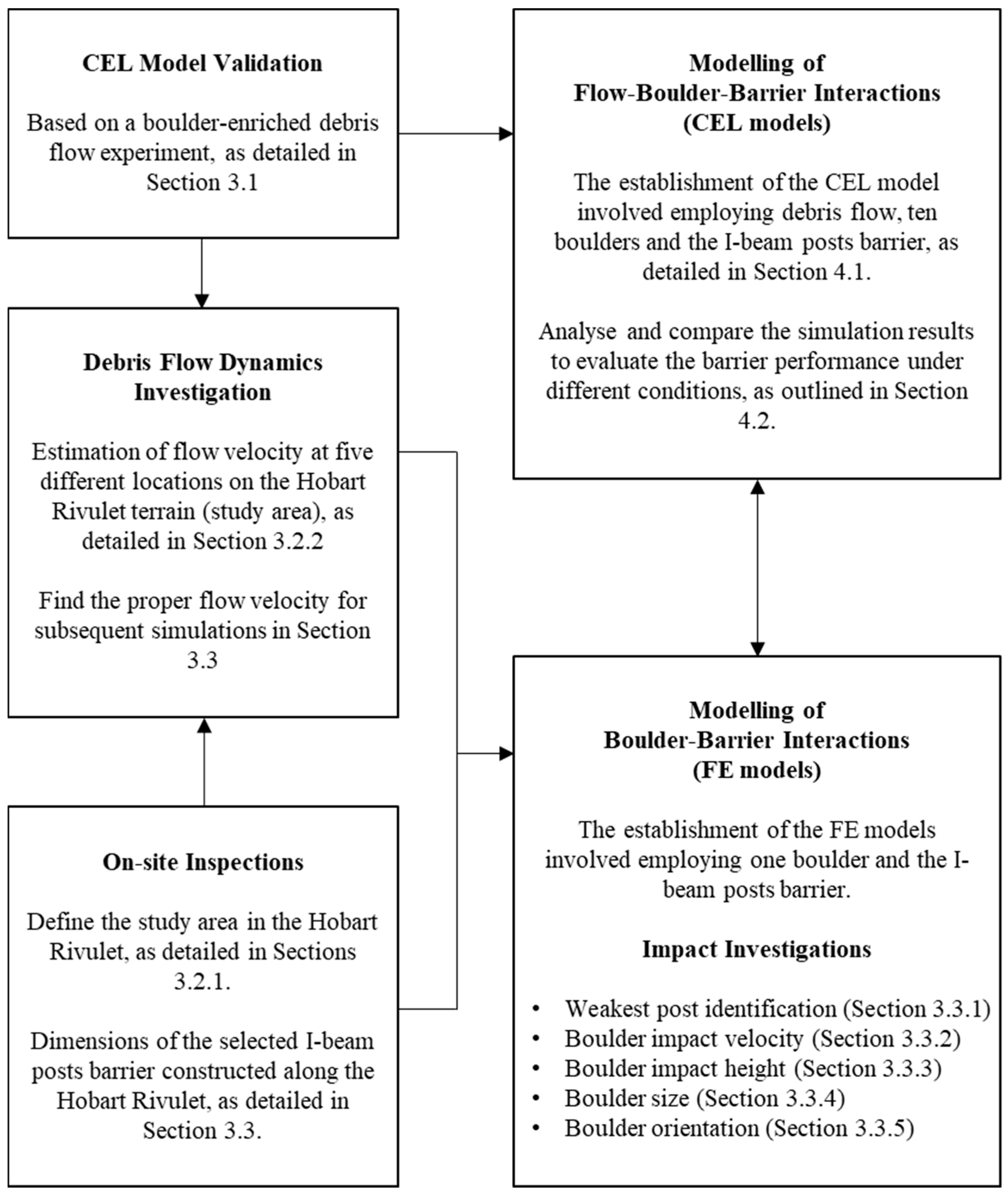
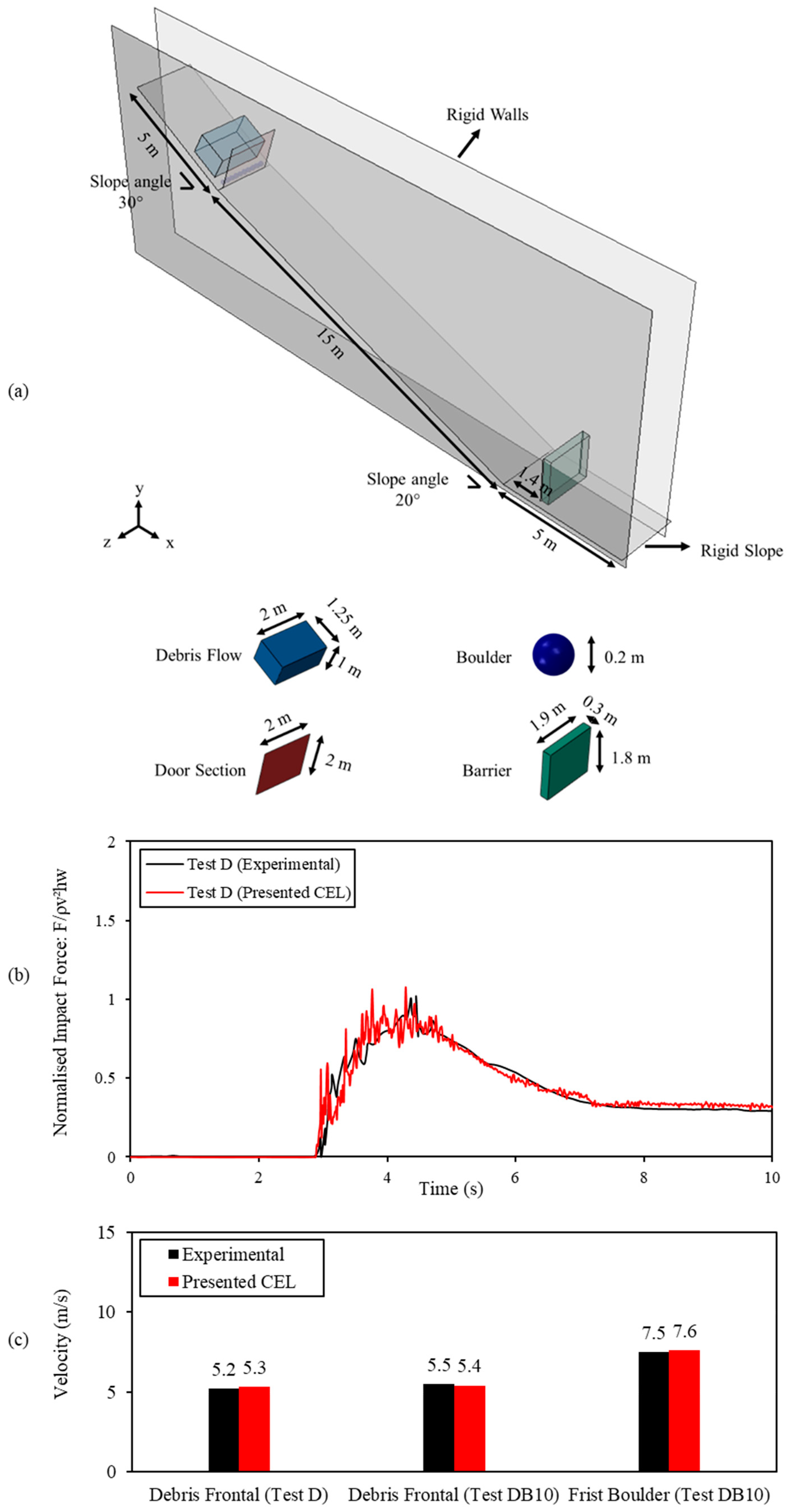
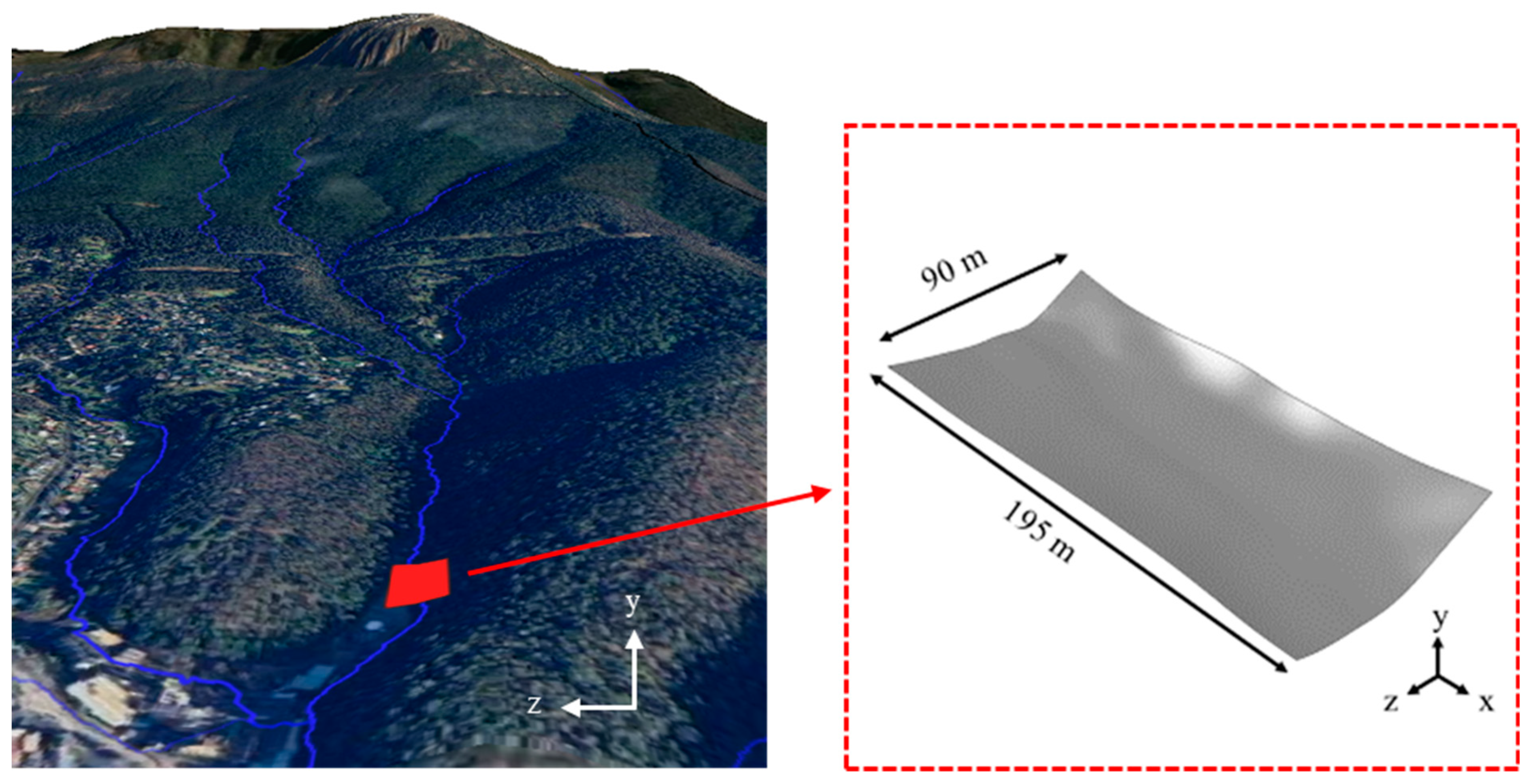
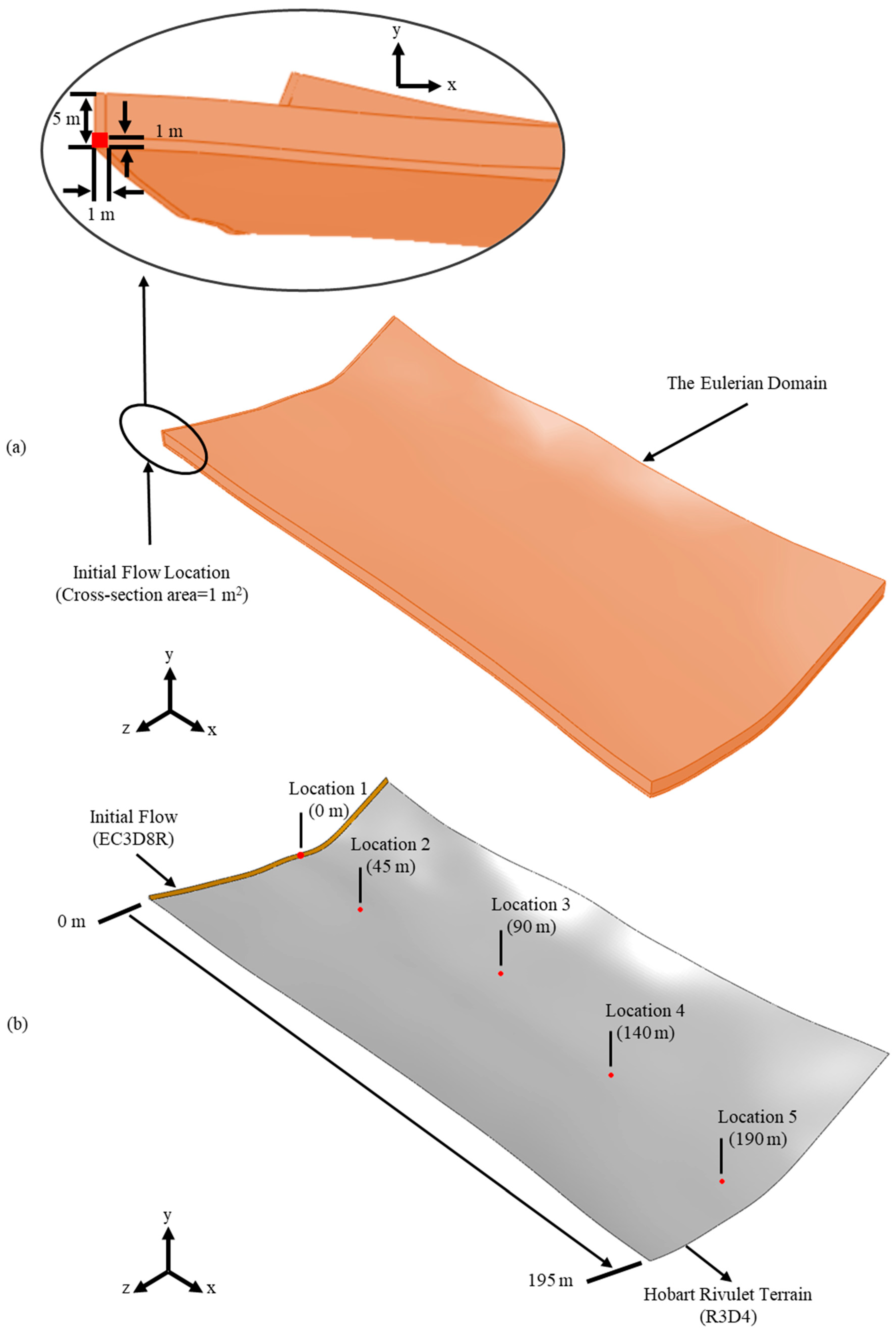

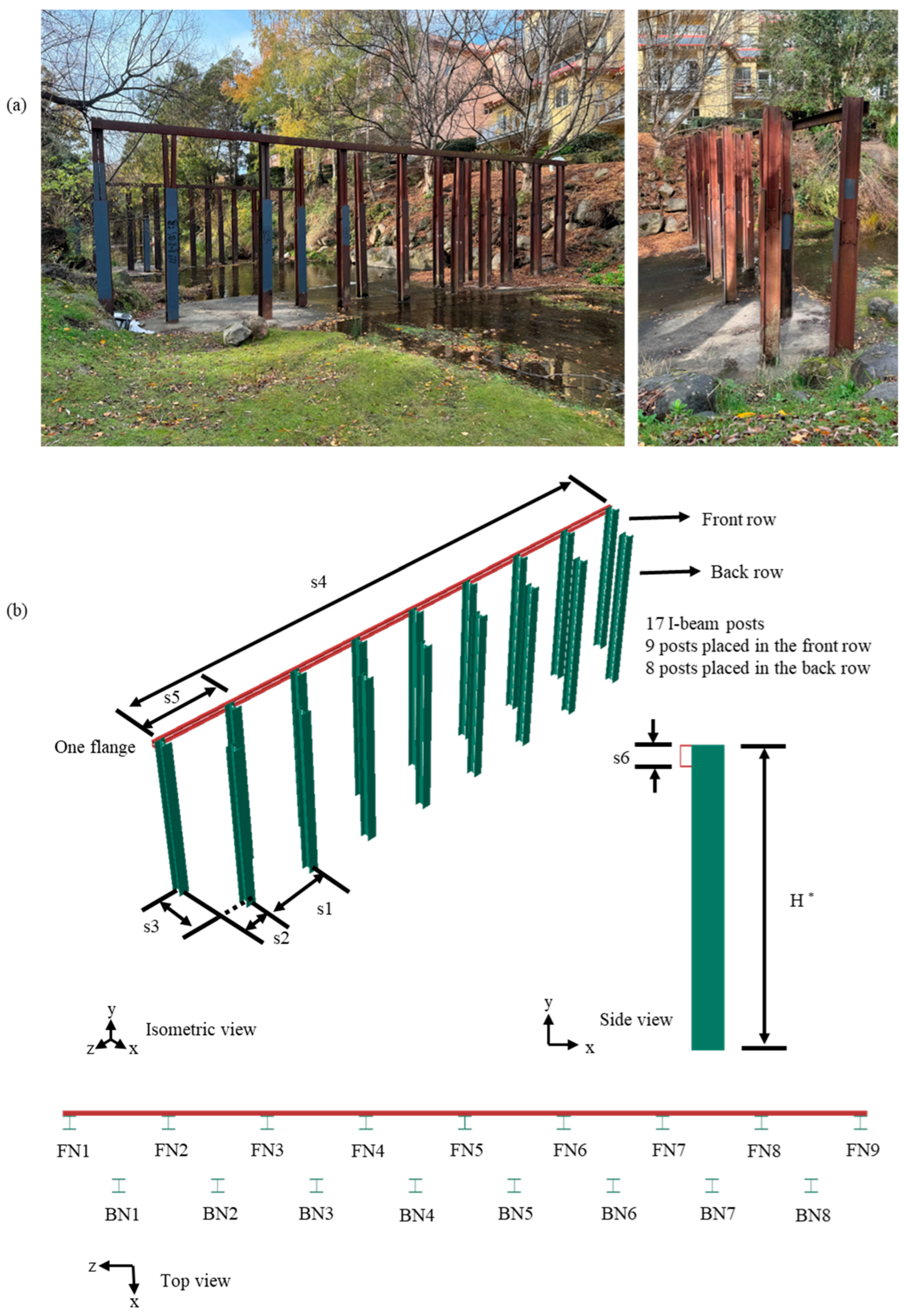
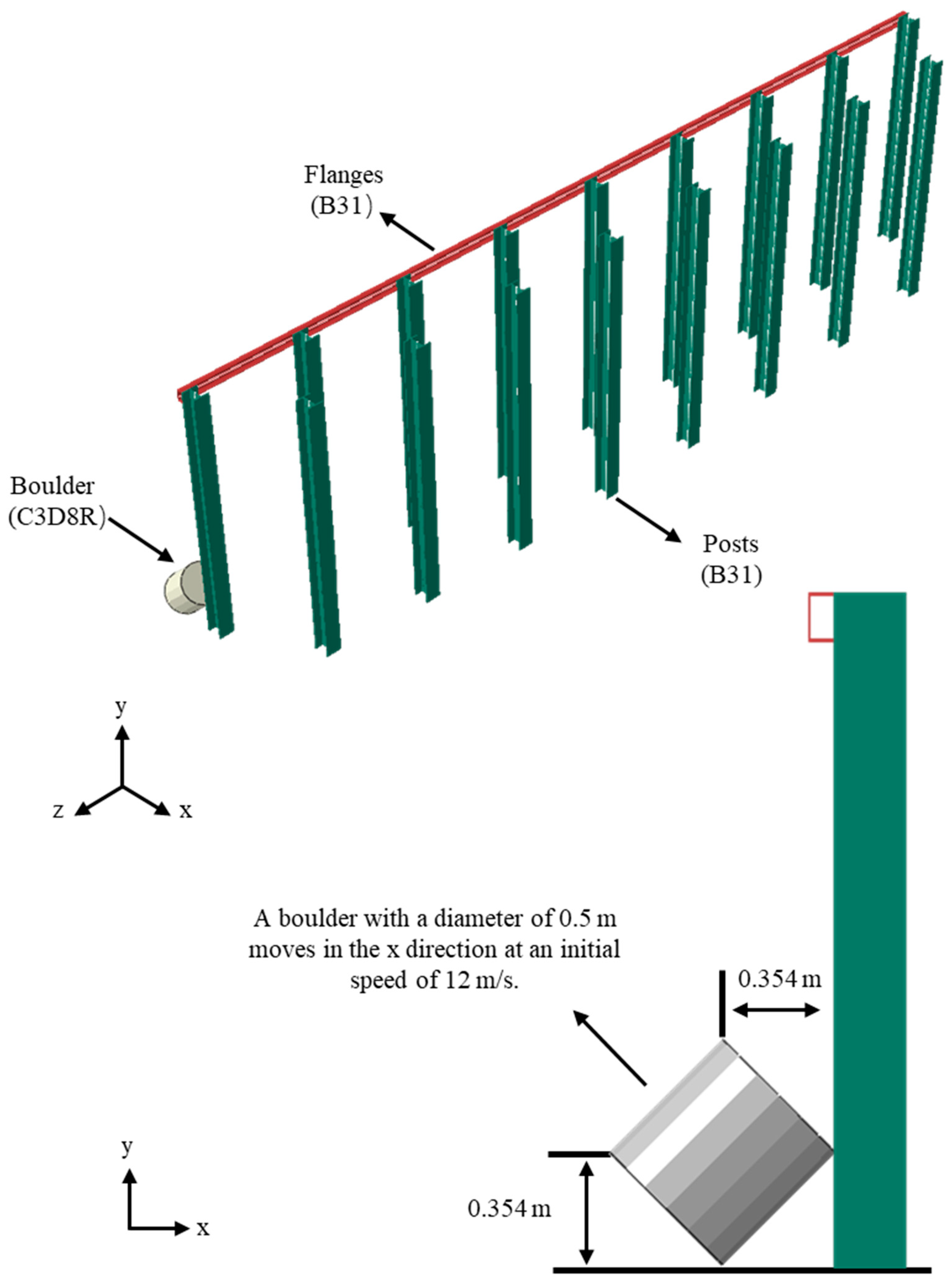
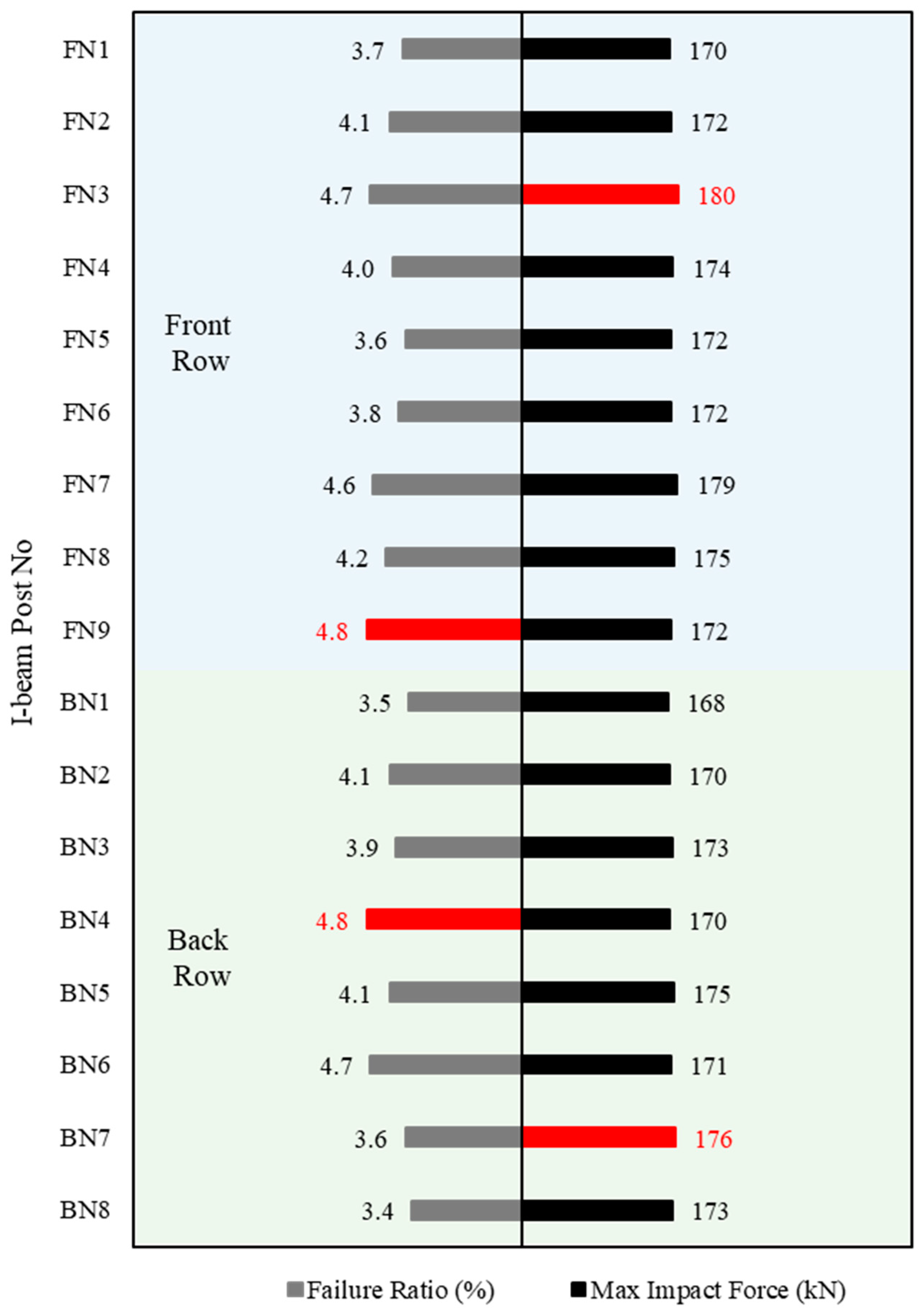
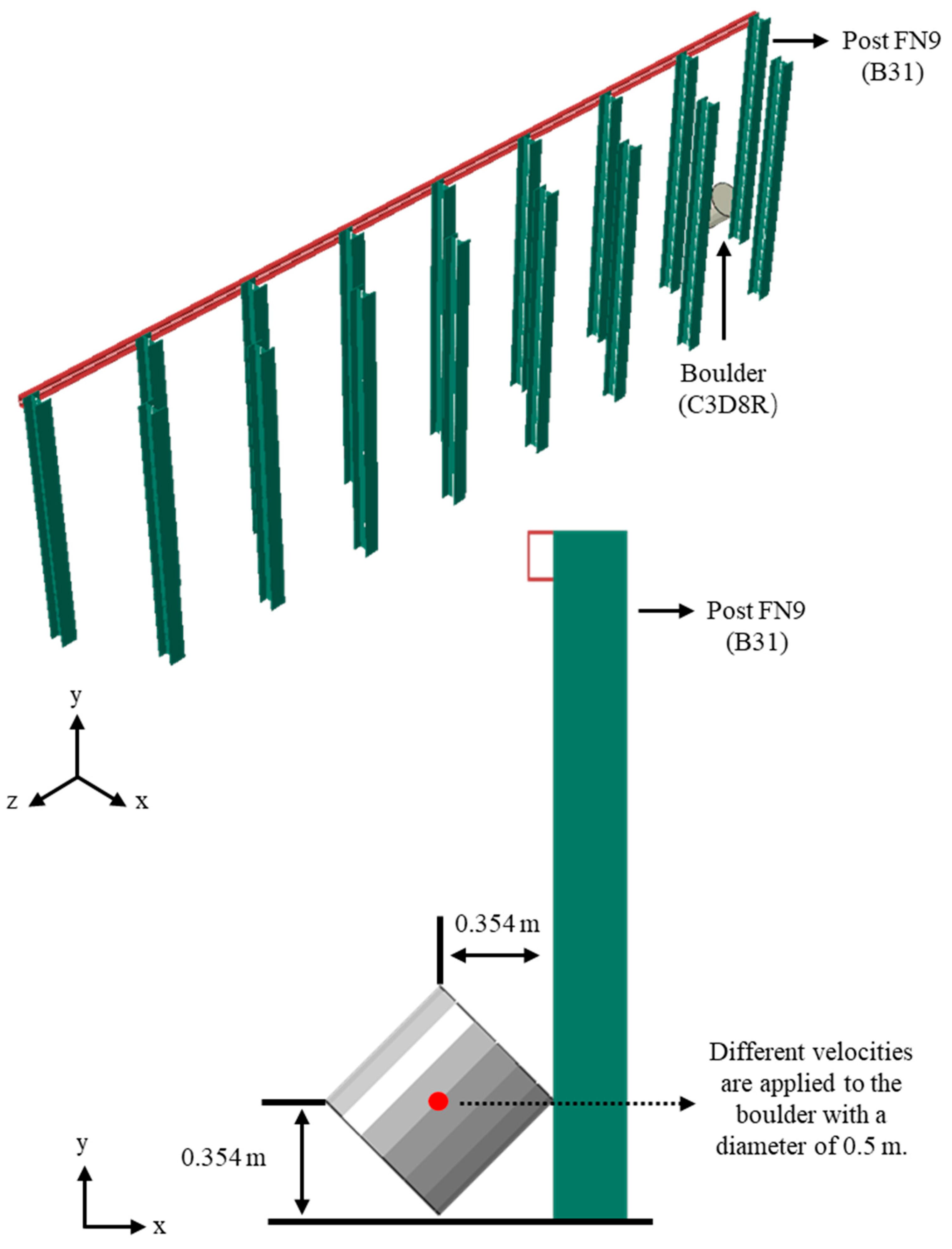
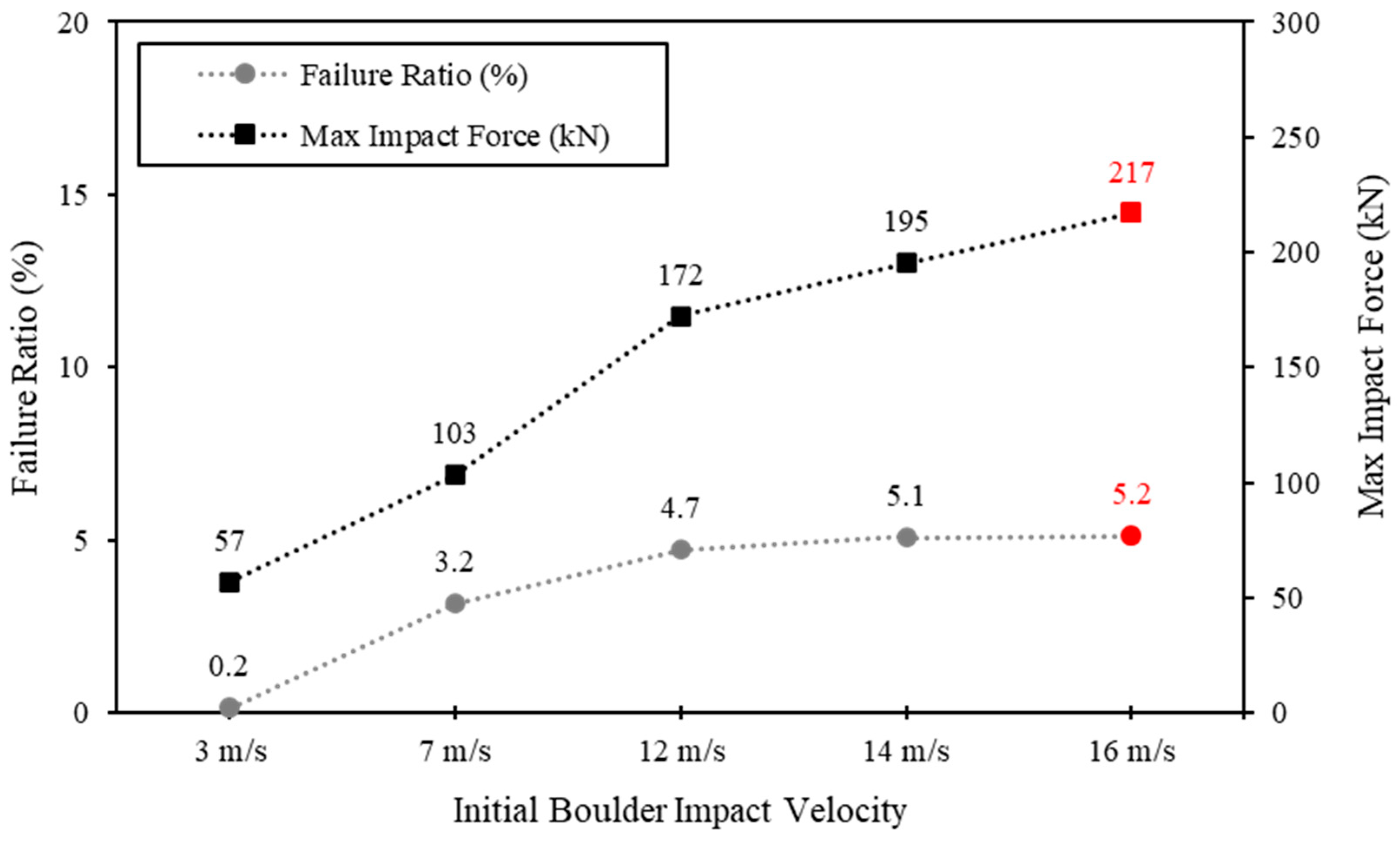
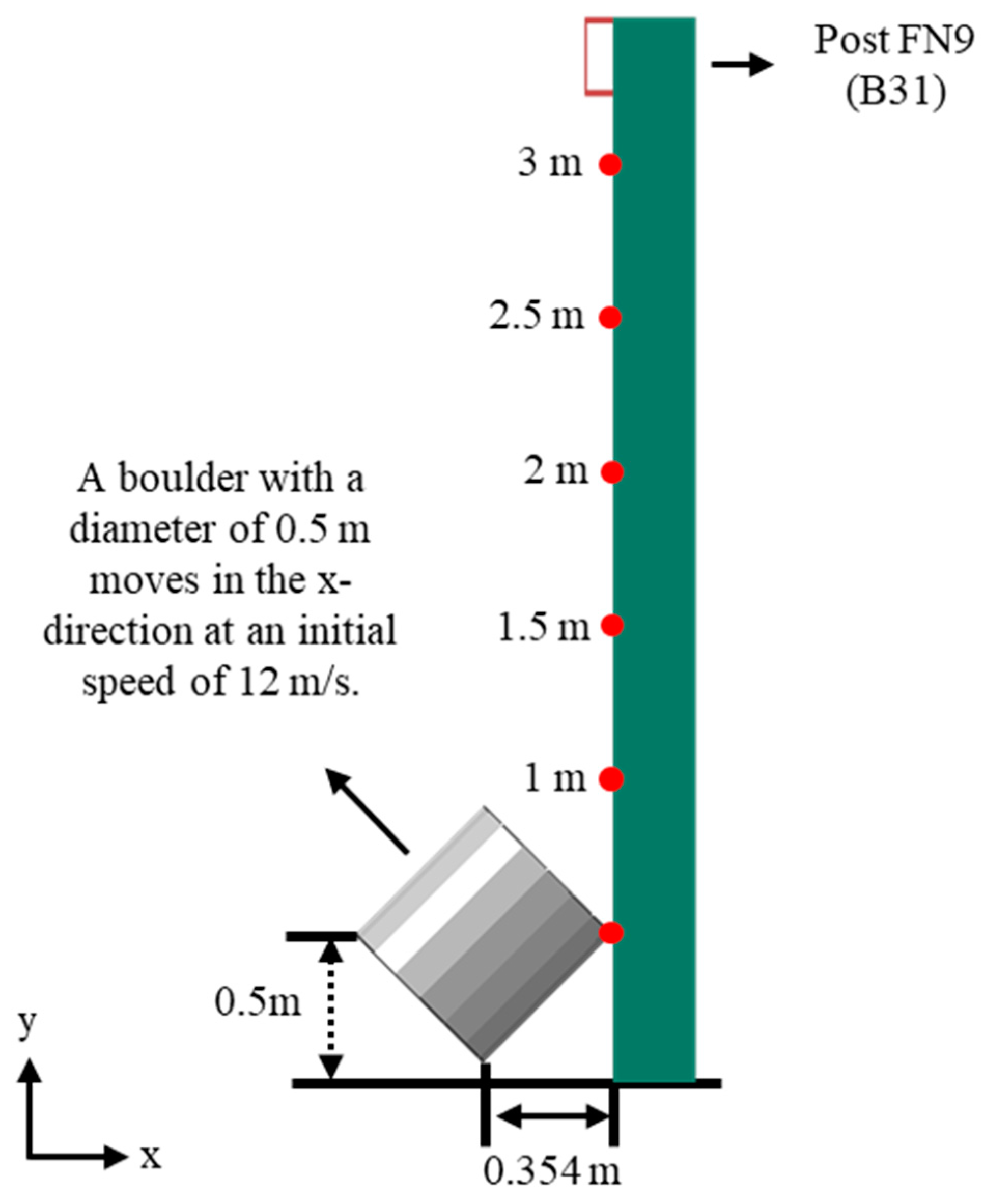
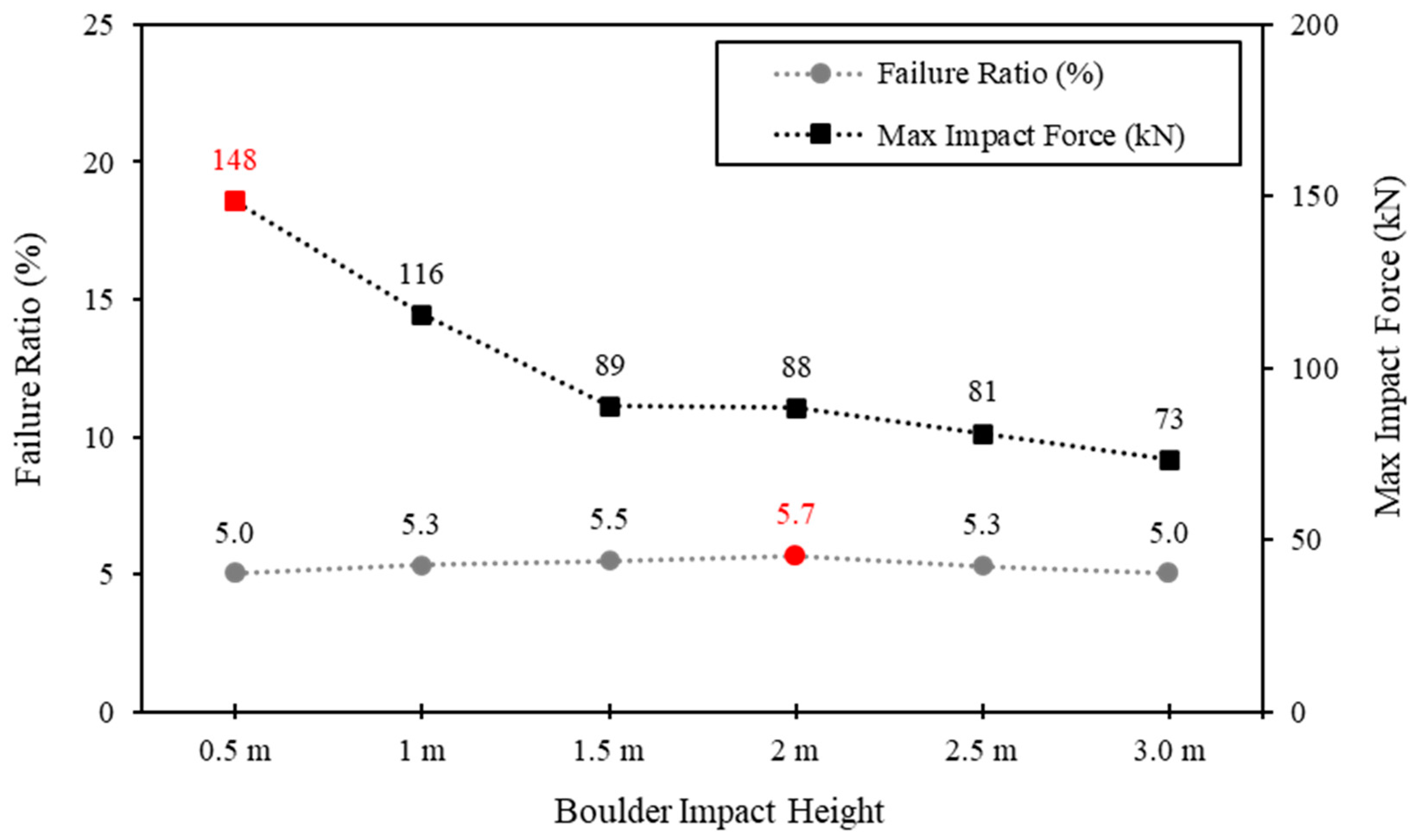
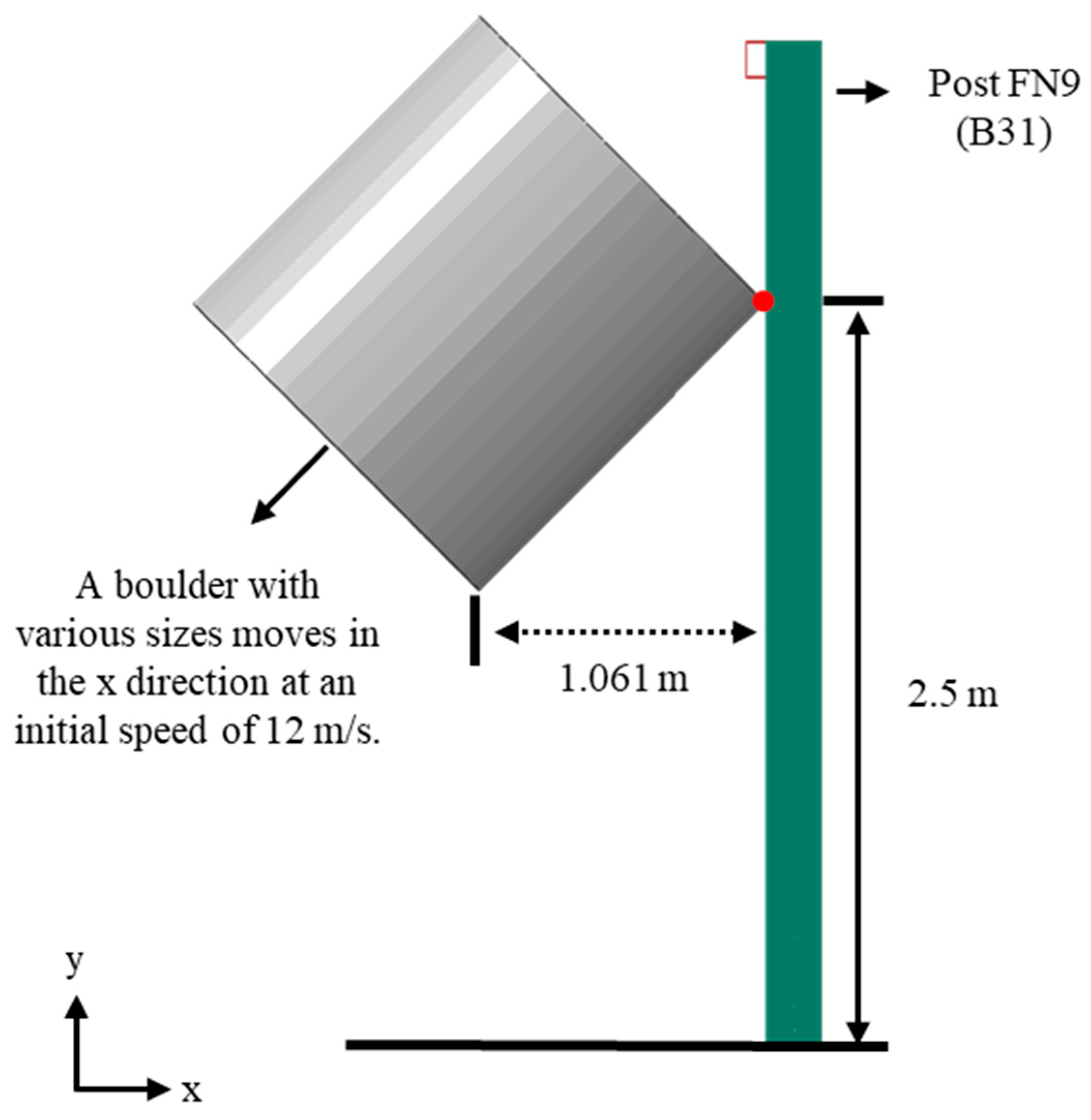
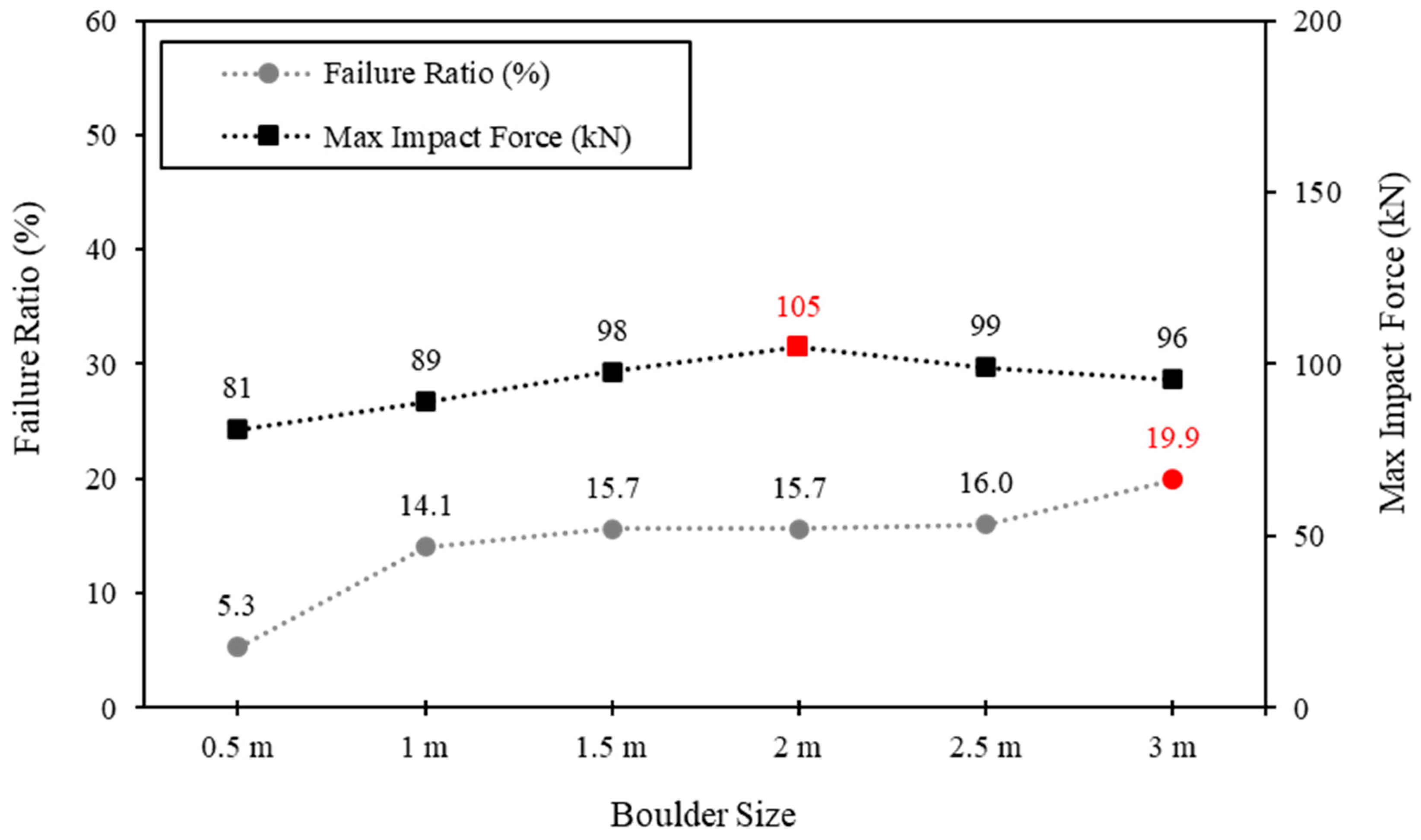
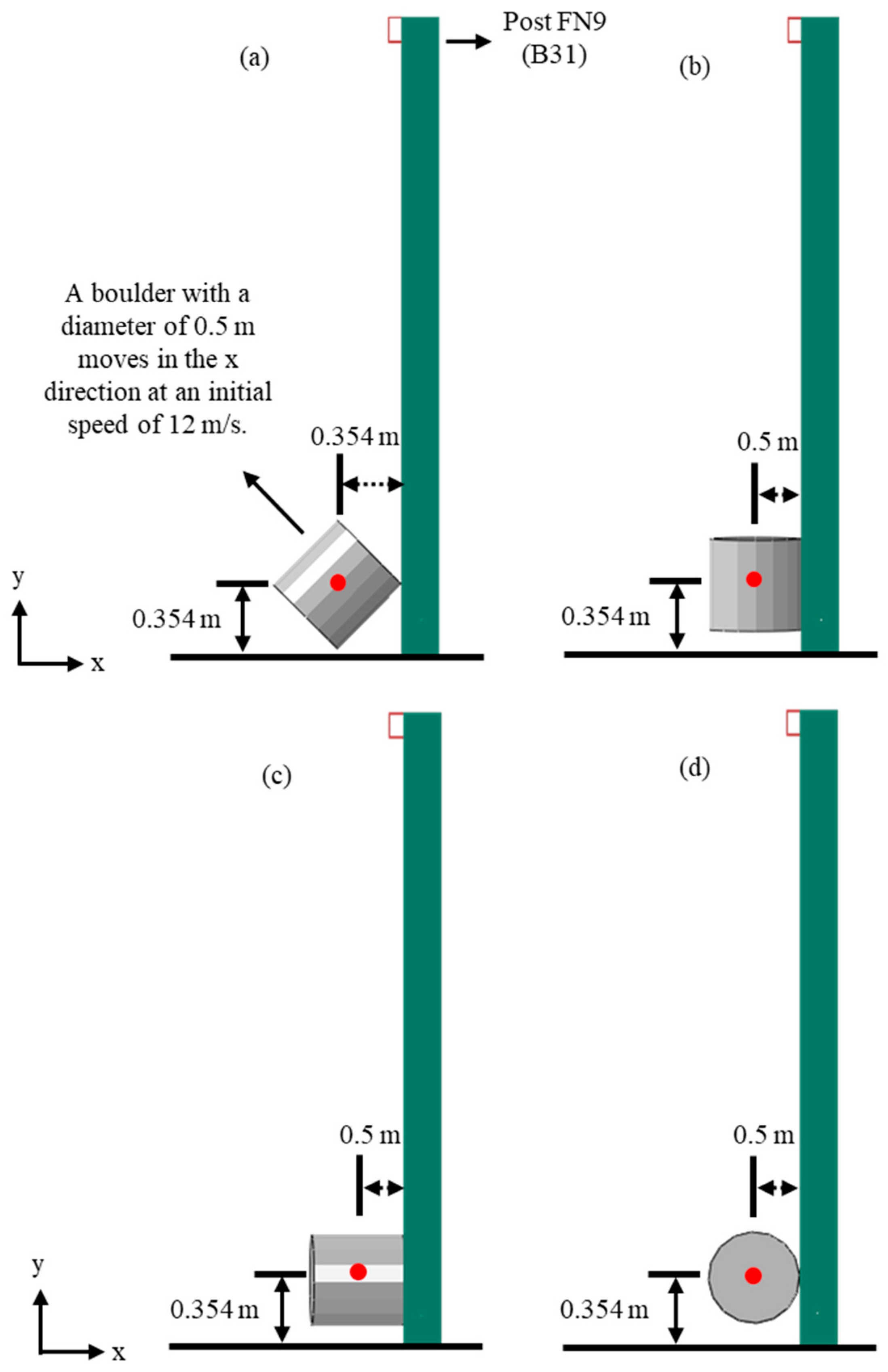

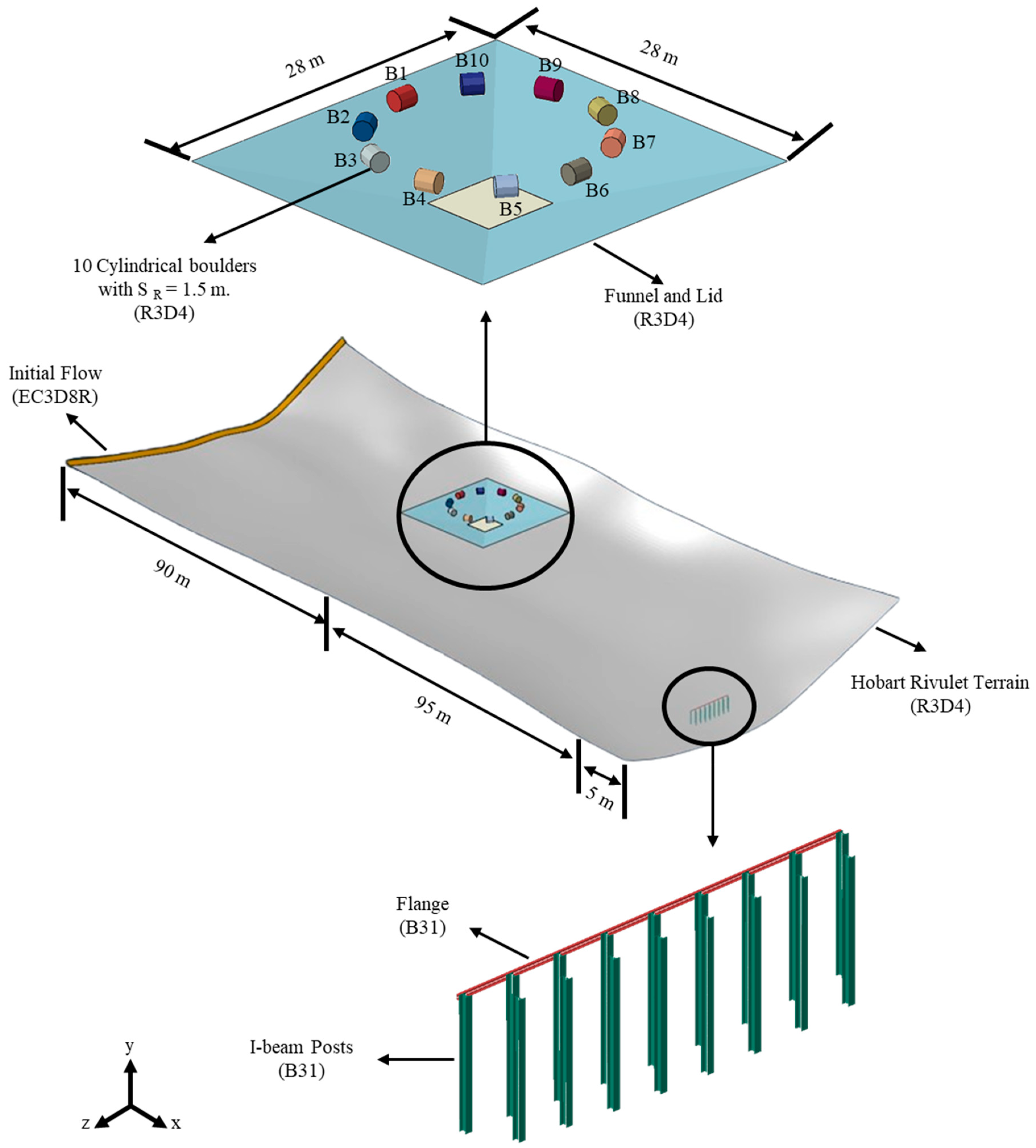


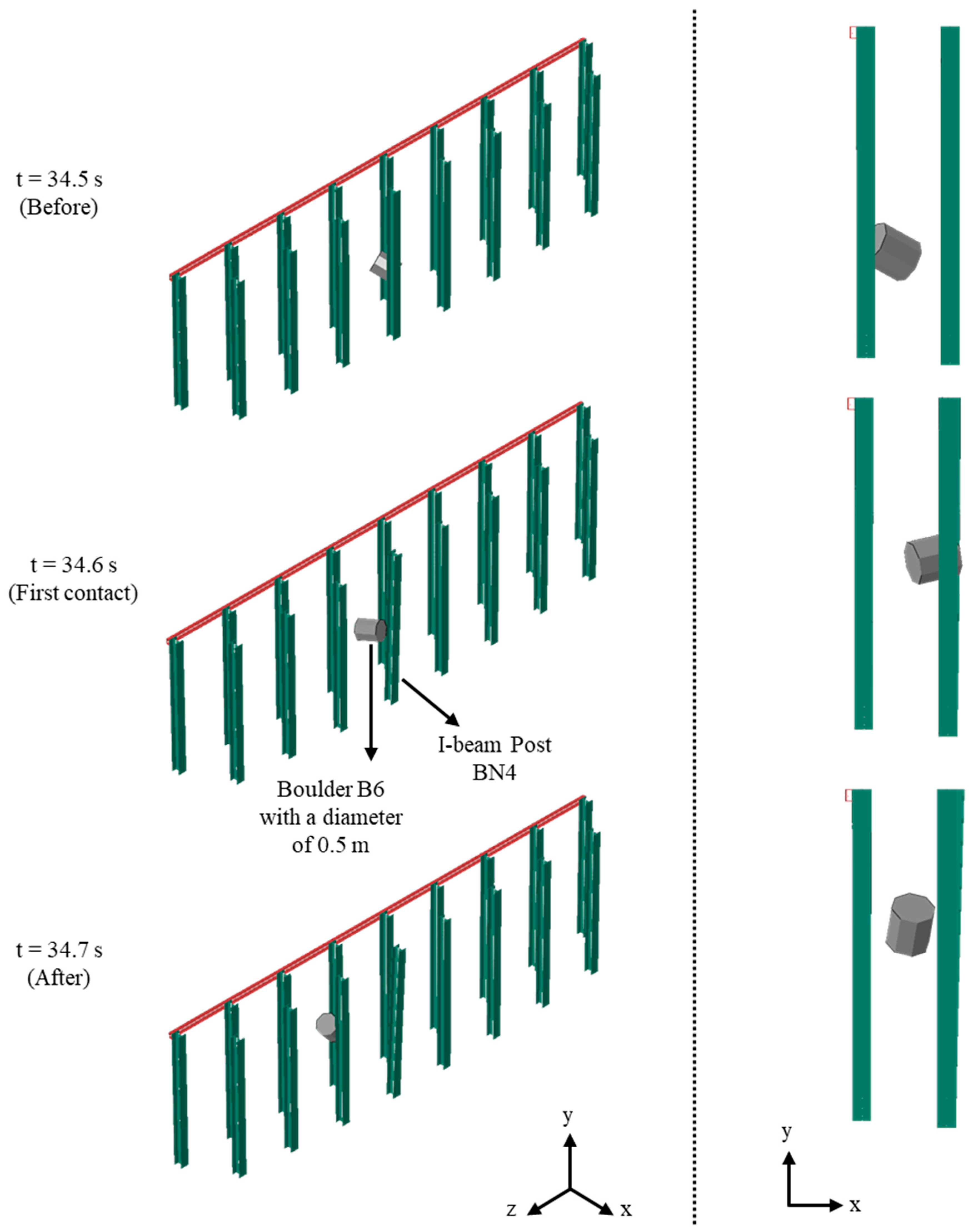

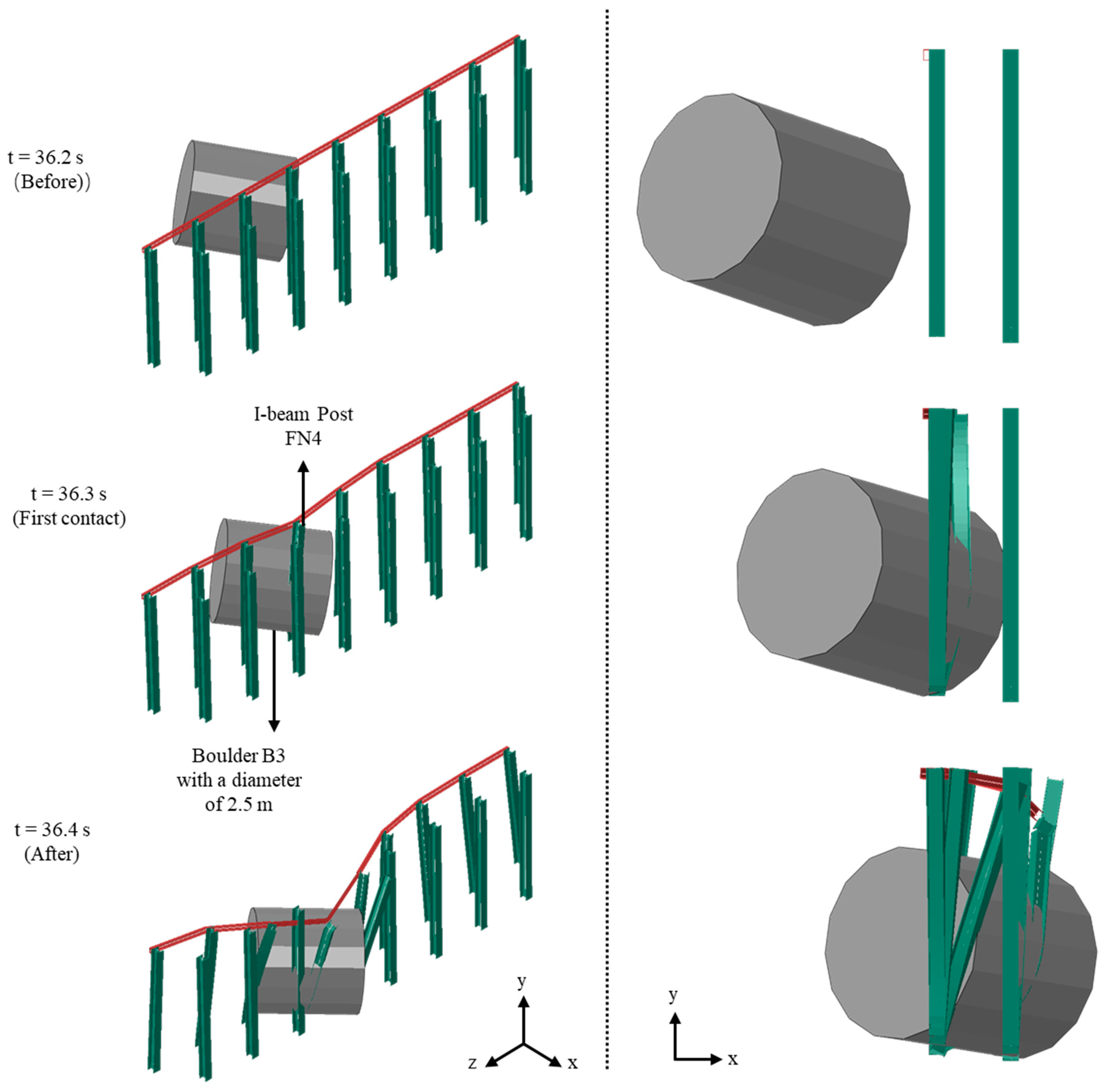
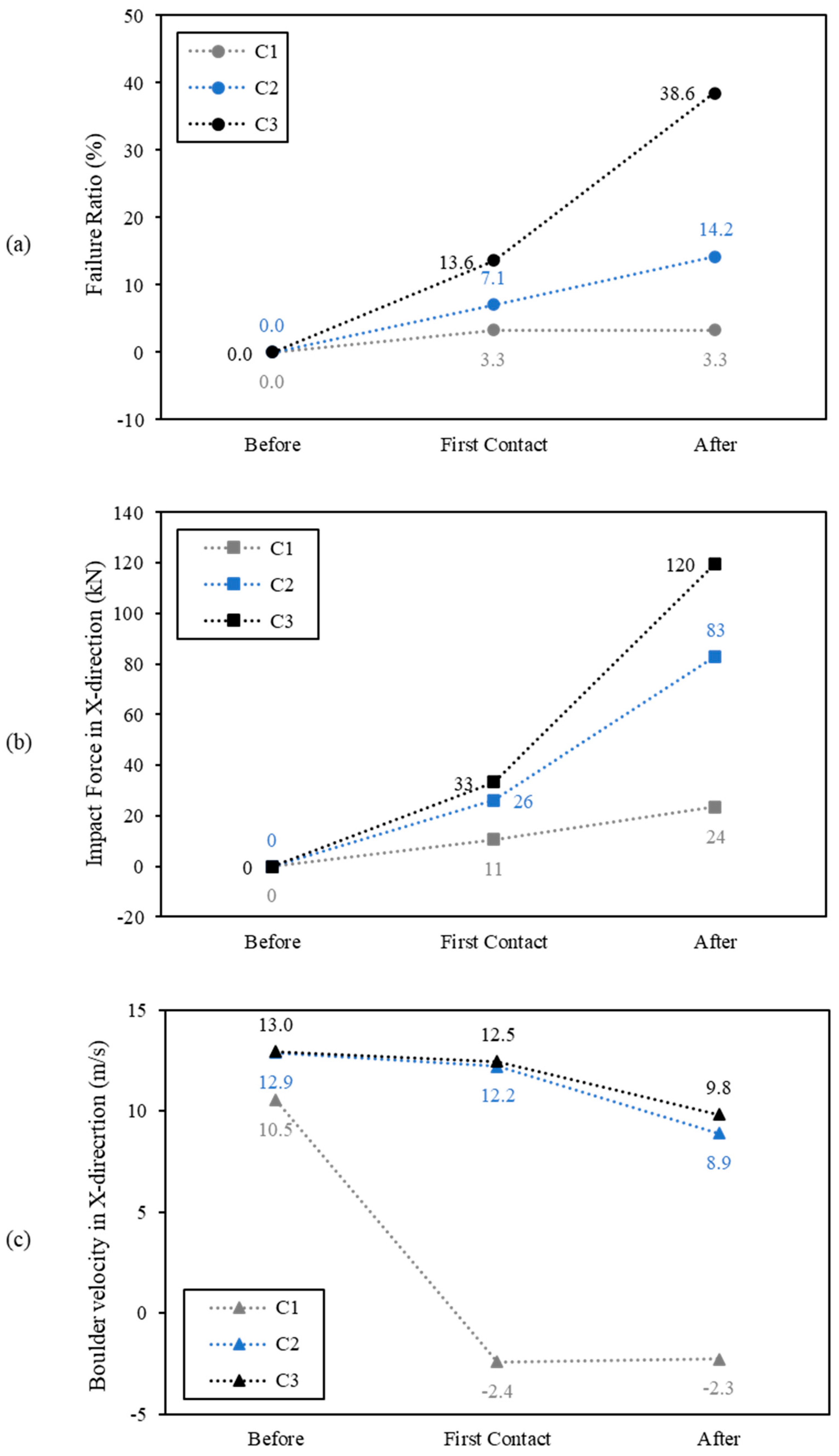
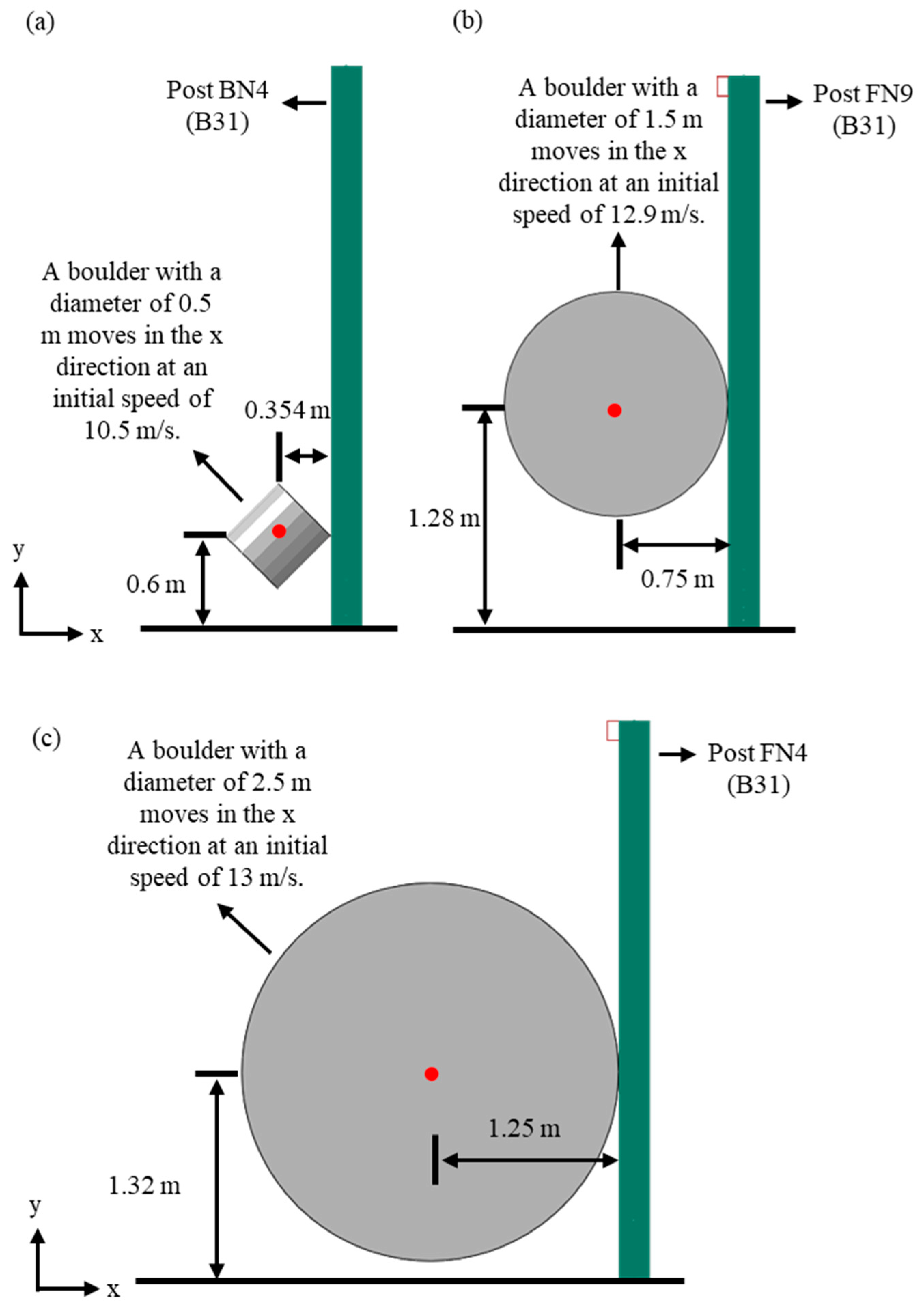



| Material Parameter | Constitutive Model | Density ρ (kg/m3) | (Pa) | (Pa·s) | Poisson’s Ratio ν | Young’s Modulus E (kPa) |
|---|---|---|---|---|---|---|
| Debris flow | Bingham | 1500 | 100 | 100 | - | - |
| Hobart Rivulet Terrain | Rigid body | - | - | - | - | - |
| Barrier * | Linear elastic | 7850 | - | - | 0.25 | 2 108 |
| Boulder * | Rigid body | 2880 | - | - | - | - |
| Beam Type |  |  |
|---|---|---|
| Classification | UC200-59 | 150PFC |
| t1 (mm) | 14.2 | 9.5 |
| t2 (mm) | 14.2 | 9.5 |
| t3 (mm) | 9.5 | 6 |
| b1 (mm) | 205 | 75 |
| b2 (mm) | 205 | 75 |
| y (mm) | 105 | 75 |
| h (mm) | 210 | 150 |
| Post Beam Type | Flange Beam Type | s1 (m) | s2 (m) | s3 (m) | s4 (m) | s5 (m) | s6 (mm) | H * (m) | |
|---|---|---|---|---|---|---|---|---|---|
| Minimum | Maximum | ||||||||
| UC200-59 | 150PFC | 1.5 | 0.75 | 0.95 | 12.205 | 1.5 | 150 | 3.31 | 3.78 |
| Geometry | Test No | Reference Size SR (m) | Volume (m3) | Mass (tons) |
|---|---|---|---|---|
 | S1 | 0.5 | 0.1 | 0.3 |
| S2 | 1 | 0.8 | 2.3 | |
| S3 | 1.5 | 2.7 | 7.6 | |
| S4 | 2 | 6.3 | 18.1 | |
| S5 | 2.5 | 12.3 | 35.3 | |
| S6 | 3 | 21.2 | 61.1 |
Disclaimer/Publisher’s Note: The statements, opinions and data contained in all publications are solely those of the individual author(s) and contributor(s) and not of MDPI and/or the editor(s). MDPI and/or the editor(s) disclaim responsibility for any injury to people or property resulting from any ideas, methods, instructions or products referred to in the content. |
© 2024 by the authors. Licensee MDPI, Basel, Switzerland. This article is an open access article distributed under the terms and conditions of the Creative Commons Attribution (CC BY) license (https://creativecommons.org/licenses/by/4.0/).
Share and Cite
Sha, S.; Dyson, A.P.; Kefayati, G.; Tolooiyan, A. Evaluating the Performance of Protective Barriers against Debris Flows Using Coupled Eulerian Lagrangian and Finite Element Analyses. Sustainability 2024, 16, 7332. https://doi.org/10.3390/su16177332
Sha S, Dyson AP, Kefayati G, Tolooiyan A. Evaluating the Performance of Protective Barriers against Debris Flows Using Coupled Eulerian Lagrangian and Finite Element Analyses. Sustainability. 2024; 16(17):7332. https://doi.org/10.3390/su16177332
Chicago/Turabian StyleSha, Shiyin, Ashley P. Dyson, Gholamreza Kefayati, and Ali Tolooiyan. 2024. "Evaluating the Performance of Protective Barriers against Debris Flows Using Coupled Eulerian Lagrangian and Finite Element Analyses" Sustainability 16, no. 17: 7332. https://doi.org/10.3390/su16177332






